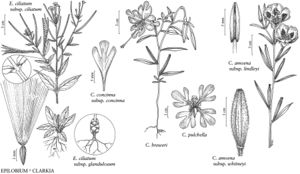familyOnagraceae
subfamilyOnagraceae subfam. Onagroideae
genusClarkia
sectionClarkia sect. Rhodanthos
subsectionClarkia subsect. Primigenia
speciesClarkia amoena
subspeciesClarkia amoena subsp. whitneyi
Clarkia amoena subsp. whitneyi
Univ. Calif. Publ. Bot. 20: 265. 1955.
Common names: Whitney’s clarkia
Basionym: Oenothera whitneyi A. Gray Proc. Amer. Acad. Arts 7: 340, 400. 1868
Synonyms: Godetia whitneyi (A. Gray) T. Moore
Treatment appears in FNA Volume 10.
Revision as of 16:58, 27 April 2022 by imported>Volume Importer
Stems decumbent, to 100 cm.Inflorescences congested racemes; bracts lanceolate; internodes shorter than subtending flowers. Flowers: petals with bright red spot mid blade, 30–60 mm; ovary broadly fusiform, 8–12 mm wide, 8-grooved, 4 deeper; stigma exserted beyond anthers. 2n = 14.
Phenology: Flowering Jul–Aug.
Habitat: Coastal scrub.
Elevation: 0–100 m.
Discussion
Subspecies whitneyi is common in cultivation, mostly as hybrid derivatives with other subspecies, but is scarce in the wild, found only rarely along the coast in Humboldt and Mendocino counties; it is listed as rare by the California Native Plant Society.
Selected References
None.
Lower Taxa
None.
